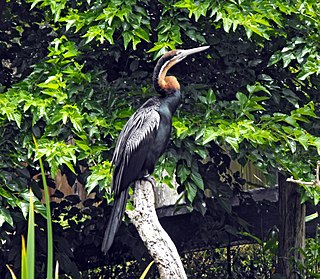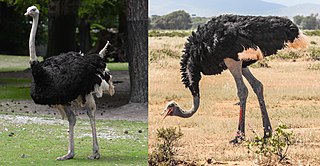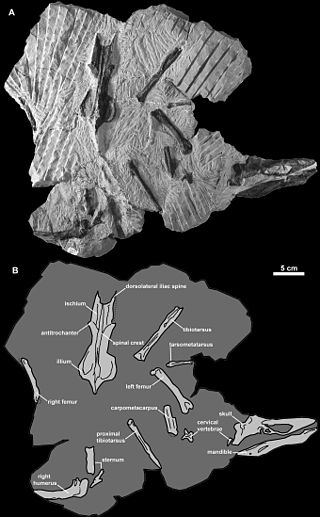
Penguins are a group of aquatic flightless birds from the family Spheniscidae of the order Sphenisciformes. They live almost exclusively in the Southern Hemisphere: only one species, the Galápagos penguin, is found north of the Equator. Highly adapted for life in the ocean water, penguins have countershaded dark and white plumage and flippers for swimming. Most penguins feed on krill, fish, squid and other forms of sea life which they catch with their bills and swallow whole while swimming. A penguin has a spiny tongue and powerful jaws to grip slippery prey.

A passerine is any bird of the order Passeriformes which includes more than half of all bird species. Sometimes known as perching birds, passerines generally have an anisodactyl arrangement of their toes, which facilitates perching.

Auks or alcids are birds of the family Alcidae in the order Charadriiformes. The alcid family includes the murres, guillemots, auklets, puffins, and murrelets. The family contains 25 extant or recently extinct species that are divided into 11 genera. Auks are found throughout the Northern Hemisphere.

The darters, anhingas, or snakebirds are mainly tropical waterbirds in the family Anhingidae, which contains a single genus, Anhinga. There are four living species, three of which are very common and widespread while the fourth is rarer and classified as near-threatened by the IUCN. The term snakebird is usually used without any additions to signify whichever of the completely allopatric species occurs in any one region. It refers to their long thin neck, which has a snake-like appearance when they swim with their bodies submerged, or when mated pairs twist it during their bonding displays. "Darter" is used with a geographical term when referring to particular species. It alludes to their manner of procuring food, as they impale fishes with their thin, pointed beak. The American darter is more commonly known as the anhinga. It is sometimes called "water turkey" in the southern United States; though the anhinga is quite unrelated to the wild turkey, they are both large, blackish birds with long tails that are sometimes hunted for food.

The Anatidae are the biological family of water birds that includes ducks, geese, and swans. The family has a cosmopolitan distribution, occurring on all the world's continents except Antarctica. These birds are adapted for swimming, floating on the water surface, and, in some cases, diving in at least shallow water. The family contains around 174 species in 43 genera.

The Accipitriformes are an order of birds that includes most of the diurnal birds of prey, including hawks, eagles, vultures, and kites, but not falcons.

Rails are a large, cosmopolitan family of small- to medium-sized terrestrial and/or semi-amphibious birds. The family exhibits considerable diversity in its forms, and includes such ubiquitous species as the crakes, coots, and gallinule; other rail species are extremely rare or endangered. Many are associated with wetland habitats, some being semi-aquatic like waterfowl, but many more are wading birds or shorebirds. The ideal rail habitats are marsh areas, including rice paddies, and flooded fields or open forest. They are especially fond of dense vegetation for nesting. The rail family is found in every terrestrial habitat with the exception of dry desert, polar or freezing regions, and alpine areas. Members of Rallidae occur on every continent except Antarctica. Numerous unique island species are known.

Phalacrocoracidae is a family of approximately 42 species of aquatic birds commonly known as cormorants and shags. Several different classifications of the family have been proposed, but in 2021 the International Ornithologists' Union (IOU) adopted a consensus taxonomy of seven genera. The great cormorant and the common shag are the only two species of the family commonly encountered in Britain and Ireland and "cormorant" and "shag" appellations have been later assigned to different species in the family somewhat haphazardly.

The bird family Sulidae comprises the gannets and boobies. Collectively called sulids, they are medium-large coastal seabirds that plunge-dive for fish and similar prey. The 10 species in this family are often considered congeneric in older sources, placing all in the genus Sula. However, Sula and Morus (gannets) can be readily distinguished by morphological, behavioral, and DNA sequence characters. Abbott's booby (Papasula) is given its own genus, as it stands apart from both in these respects. It appears to be a distinct and ancient lineage, maybe closer to the gannets than to the true boobies.

The magpie goose is the sole living representative species of the family Anseranatidae. This common waterbird is found in northern Australia and southern New Guinea. As the species is prone to wandering, especially when not breeding, it is sometimes recorded outside its core range. The species was once also widespread in southern Australia but disappeared from there largely due to the drainage of the wetlands where the birds once bred. Due to their importance to Aboriginal people as a seasonal food source, as subjects of recreational hunting, and as a tourist attraction, their expansive and stable presence in northern Australia has been "ensured [by] protective management".

Anseranatidae, the magpie-geese, is a biological family of waterbirds. The only living species, the magpie goose, is a resident breeder in northern Australia and in southern New Guinea.

Dromaius is a genus of ratite present in Australia. There is one extant species, Dromaius novaehollandiae, commonly known as the emu.

Anas is a genus of dabbling ducks. It includes the pintails, most teals, and the mallard and its close relatives. It formerly included additional species but following the publication of a molecular phylogenetic study in 2009 the genus was split into four separate genera. The genus now contains 31 living species. The name Anas is the Latin for "duck".

Ostriches are large flightless birds. Two living species are recognised, the common ostrich, native to large areas of sub-Saharan Africa, and the Somali ostrich, native to the Horn of Africa.

Mancallinae is an extinct subfamily of prehistoric flightless alcids that lived on the Pacific coast of today's California and Mexico from the late Miocene epoch to the early Pleistocene. They are sometimes collectively referred to as Lucas auks after the scientist who described the first species, Frederic Augustus Lucas.
Ilbandornis was a genus of ostrich-sized dromornithid, a clade known casually as "demon ducks" because they are most closely related to the water fowl clade anseriformes. It was far more lightly built than other members of the family, indicating a more cursorial lifestyle; it was a fast runner. The majority of researchers consider Dromornithids to be herbivorous; this is borne out by molecular analysis of the gastroliths and eggshells of both Ilbandornis and the related Genyornis. While Ilbandornis and Genyornis have skulls of similar size to emus, other Dromornithids such as Dromornis have far more robust skulls with large beaks; these were previously considered an adaptation for carnivory, but their blunt edges and lack of hooked tip indicate that the species were herbivorous. It is therefore likely that the differences in skull shape are due to differences in diet. Ilbandornis went extinct sometime in the Miocene epoch.
Hoazinoides is an extinct genus of birds from the Middle Miocene (Laventan) from the "Monkey Beds" of the Villavieja Formation of the Honda Group at the Konzentrat-Lagerstätte of La Venta, Colombia.

The order Suliformes is an order of birds recognised by the International Ornithologist's Union. Regarding the recent evidence that the traditional Pelecaniformes is polyphyletic, it has been suggested that the group be divided to reflect the true evolutionary relationships; a 2017 study indicated that they are most closely related to Otidiformes (bustards) and Ciconiiformes (storks).
Rupephaps taketake, also referred to as the Saint Bathans pigeon, is an extinct species of pigeon from the Miocene of New Zealand. It is the first species of columbid to be described from pre-Pliocene fossil deposits in the Australasian region.

Petralca is an extinct genus of loon found in Oligocene and Miocene deposits of Austria. The type and only species, Petralca austriaca, was described in 1987. It is the only member of the Petralcinae subfamily. Originally thought to be the oldest representative of auk in Europe, it was reinterpreted as a member of Gaviiformes by Göhlich & Mayr (2018).
















